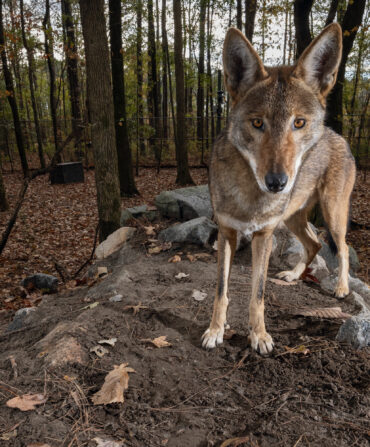Sporting
From Rock Bottom to Key West Fishing Phenom
Many consider permit to be the pinnacle of fly fishing. But it took hitting a personal low before Nathaniel Linville could truly begin his quest to become one of the best permit fishermen alive
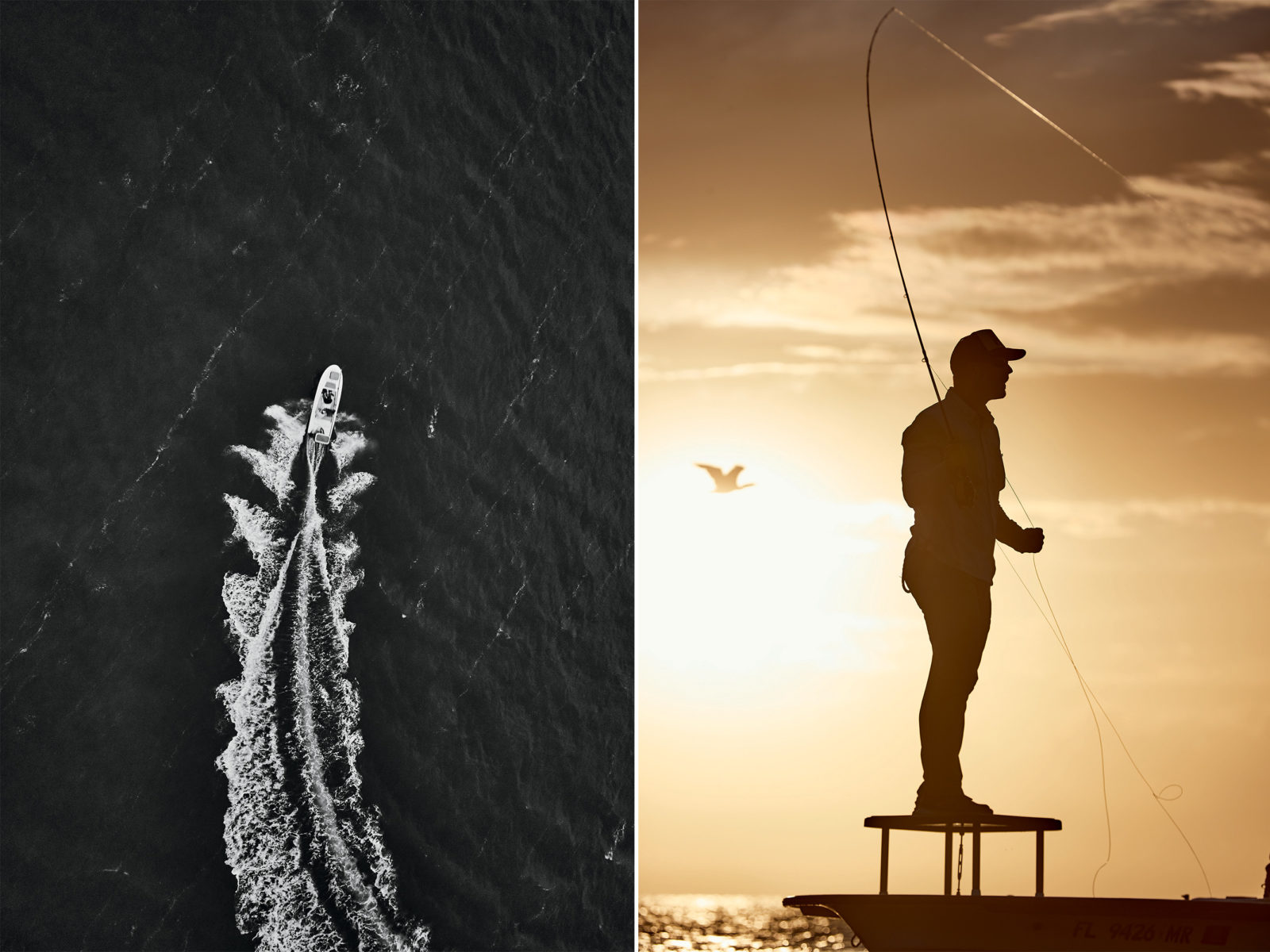
Photo: William Hereford
From left: John O’Hearn’s skiff rips across the waters off Key West; Nathaniel Linville takes to the casting platform at sunrise.
The beginning of the end comes one sultry night in Key West.
An evening like so many here, Nathaniel Linville thinks, even as he wonders if he’ll be around to ever witness another. Linville has just used the last of his cocaine. It’s only a temporary fix, though, something to stave off the crushing, terrifying pain of withdrawal from his other addiction, heroin.
He walks out of his apartment—its floor covered with newspapers, a month’s worth of dirty clothes, and scattered piles of needles—and into the darkened streets. He has a hundred dollars in his pocket, what’s left of his money. He owes far more than that amount to every dealer in town, so this is a fishing expedition, and a blind one at that.
In the shadows, just off a backstreet, he spots a man sitting on a piece of old coral rock, exactly the type of man, Linville knows after all of these years, that he’s looking for. He sits down next to him. The man pulls out a crack pipe, takes a hit, and then offers it to Linville. Linville inhales a hit and wipes his dripping nose—a telltale sign that the dope sickness is already beginning—and then tells the man that he is looking for that “boy,” slang for the heroin he so desperately wants.
“I got you,” the man says. “I got you.”
Linville hands him all of his money. He knows better, but the cocaine and the fear and the sickness override any logic. The man walks away, swearing he’ll be right back. Just wait right here. Linville does as he’s told. The hours tick away. He eventually returns to his apartment, empty-handed, and sits on the edge of his bed. He is totally broke, out of drugs, and shaking with the sickness. He decides at that moment that he needs help.
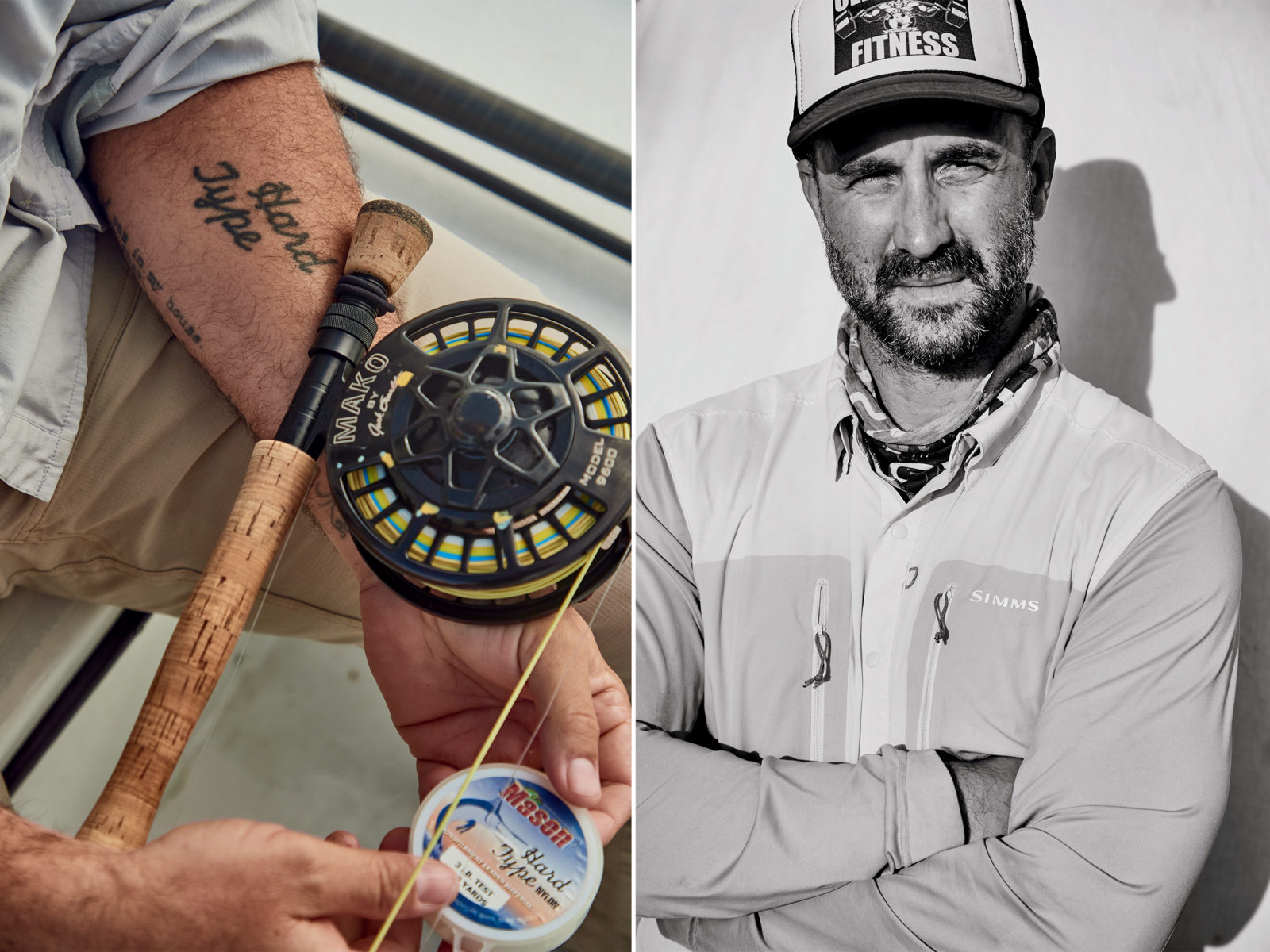
Photo: William Hereford
From left: Tools of the trade; Linville slows down for a moment during the busy winter season.
It’s eleven years later now, the winter of 2021. Nathaniel Linville is standing in the bow of a skiff that’s floating on a turtle grass flat near Man Key, just off of Key West. He is tall and dark haired, with maybe a week’s worth of scruff on his face, and stout from the weight lifting he does religiously.
The water ripples as it hurries off the flat with the falling tide. Linville scans the area, looking for any disturbance in the matrix of brown and green grasses, white spots of sand, and turquoise-stained deeper holes—a mud, a mooning flash of silver, a tail—any sign of the maddening and obsessed-over fish known as a permit.
On the platform on the back of the skiff, scrutinizing the flat from his higher perch, stands John O’Hearn. He is a forty-eight-year-old native Baltimorean who has been guiding in Key West for twenty-two years. He has carvings of permit on his belt buckle and necklace.
Linville and O’Hearn have fly fished for permit together for nearly four hundred days over the past dozen years. Of the astounding 254 permit Linville has caught in his life, around half have been with O’Hearn, including a sixteen-pounder that is the standing world record for the fish on two-pound tippet. In recent years, they have won three permit tournaments, which rank among the most competitive fishing competitions in the world. Today, they are “trying to solve another problem that has never been solved before,” as Linville describes it. That is, they are attempting to catch a permit of over twenty-four pounds with four-pound tippet, the fish that would break a world record that has stood for thirty years. Success would bring Linville’s fly rod world record count to five: Along with the two-pound tippet permit record, he also has the six-pound record for tarpon and the two- and four-pound records for whaler sharks.
Linville, who is thirty-nine, is now clean and sober. He owns a business (the Angling Company, a Key West fly shop), and is a husband and a new father. He is intense, articulate, and assertive in his beliefs. He is also, as the fly-fishing icon Andy Mill has described him, “probably the best saltwater fly angler in the world right now.”
I see something,” O’Hearn says.
“Donde?” Linville asks.
“I had a tail to the left there, about eighty feet.”
“That darker section out there?”
“Yeah, right in front of it.”
Linville stares, craning his neck forward and standing like a fencer, one arm behind his back, the other pointing his rod.
“That’s where he is,” O’Hearn says.
A moment later, the permit shows itself, its scimitar-like tail popping up, slashing the air, as if accepting a duel that’s tipped decidedly in its favor. The fish doesn’t look quite big enough for the record, but there’s only one way to know for sure.
Linville begins his cast. Unlike many flats fishermen, he is not rushed or overcome with anxiety when he spots a fish. His casting stroke is long, graceful, and, most notably, slow. “Nat is unquestionably the best caster I’ve ever seen,” O’Hearn says. It is a remarkable thing to witness, this illusion that those at the top of a sport can create—think of Michael Jordan in midair—of slowing down time.
After two false casts, Linville lays down the fly maybe two feet to the left of the fish, so the current will swing it in to it. He makes a series of long, slow strips. The fish swoops over for a look at the fly…and then zips away, off the flat, ending a fairly typical encounter.
“I maybe could have led him a bit more?” Linville says.
“Maybe,” O’Hearn says. “But I think you did everything right.”
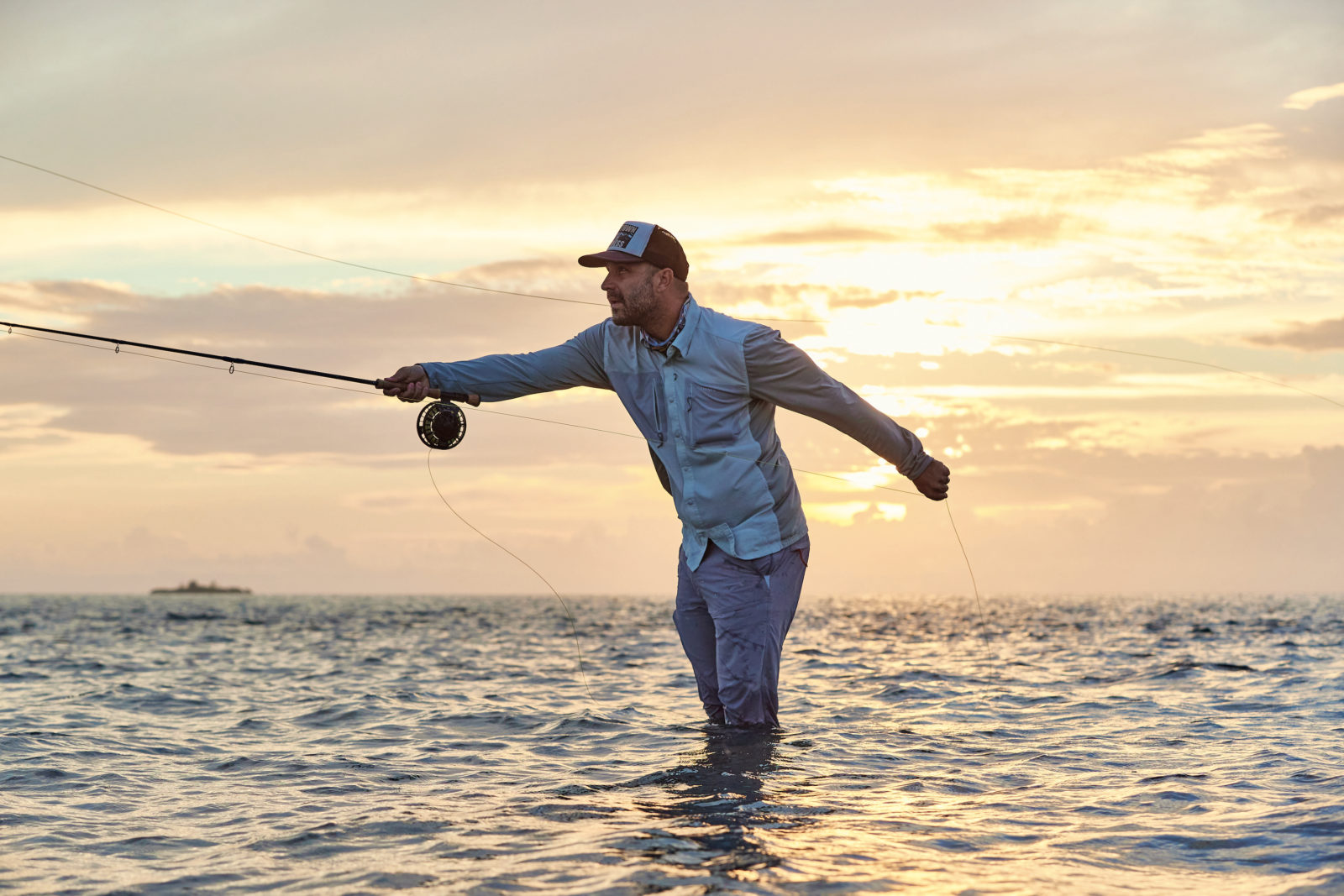
Photo: William Hereford
Casting to a tailing permit at dawn.
Permit possess neither the sleek shape of a bonefish nor the beautiful brawn of a tarpon. They look like oversize pompano; both fish are members of the jack family. They live primarily in the western Atlantic’s deep water, from Massachusetts down to the eastern coast of South America (they have closely related family members in both the Pacific and Indian Oceans). But in certain parts of the world, they come shallow, cruising the flats in search of food, like crabs and shrimp. It is on those flats where true permit fanatics come into contact with them. And there is no place more hallowed for chasing permit on the flats than the Florida Keys.
As the sport of flats fishing for bonefish and tarpon began to ascend in the 1960s and ’70s, permit were mostly an afterthought, regarded as no more worth a cast than the barracuda or jacks that also sometimes come shallow. Even when some anglers began to target them, they remained a back-burner fish, primarily because of their difficulty. They can be—in the Keys, especially—an exasperating fish, hard to find and harder to fool. Weeks and even months can go by without catching one, or even really having a good shot. Even the best permit guides, like O’Hearn—who fishes for them maybe sixty days a year—catch very few, maybe twenty-five a year. The most famous story ever written about the species (Thomas McGuane’s “The Longest Silence”) is about all of the time you spend not catching them. The famous flats fishing guide Steve Huff describes permit as “dishonest” fish. “You can do everything exactly right,” he says, meaning the cast, and the placement and movement of the fly, “and they will still screw you.”
Despite his sentiment, it is Huff and the angler Del Brown who are widely credited with popularizing fly fishing for permit in the 1980s.
Other anglers had, of course, fished for them well before then, but it was the duo’s single-minded pursuit of the fish—and the proof that the nervous Nellies could, indeed, actually be caught with relative frequency—that caused their esteem to soar.
During his fishing career, Brown, who is considered the GOAT of the discipline, caught 513 permit (the vast majority of them with Huff) with a fly rod and once held seven world records for them (all but one with Huff). Two of those records still stand, nineteen years after his death, one of them the four-pound record that Linville is attempting to break. The other is the biggest fly rod permit ever recorded by the International Game Fish Association (IGFA)—the keeper of fishing world records—a 41-pound, 8-ounce giant caught near Key West on a flat that has since been known as Scene of the Crime.
Permit are deeply polarizing fish. One is either madly obsessed with them or wholly put off by them. Linville and O’Hearn stand firmly within the former camp. The difficulty, they believe, is the entire point. Permit encompass both the why and the why not in life, according to Linville. “You look at them and realize how difficult they are to catch and ask yourself, ‘Why would I try that?’” he says. “But then you look at them and realize how difficult they are to catch and wonder, ‘Why not?’”
Many sportsmen and -women like to wax poetic about their quarry, an impulse that dates back to the cave paintings rendered by our long-ago ancestors. Not Linville. “Permit are beautiful and everything, but the fact is that success is rare with them, and the less likely the chance for success in an endeavor, the more valuable the endeavor becomes.” When one decides to fish with a fly rod, one has already put oneself at a disadvantage. Fishing for permit with a fly rod amplifies the disadvantage, making it perhaps the purest expression of the sport. “They are unfair, but I adore that about them,” he says. “Who wants fair?”
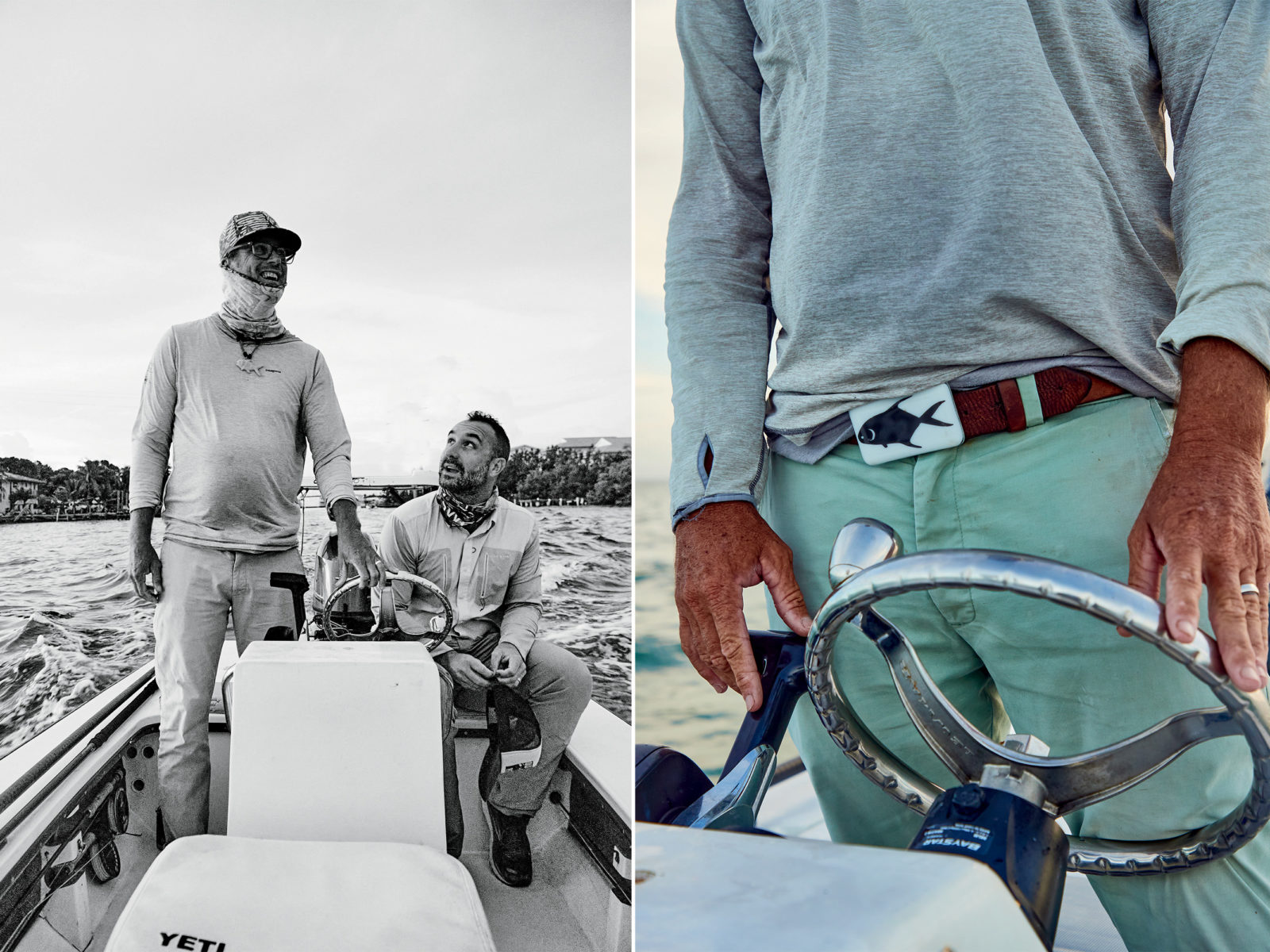
Photo: William Hereford
From left: O’Hearn and Linville share a laugh as they motor out to the flats; O’Hearn at the wheel with his trademark permit belt buckle.
Linville grew up in Norwalk, Connecticut. His father founded and ran a sailcloth company. His mother worked as a buyer for a retail skiing company. She is also an ardent angler and was, for many years, the president of the Woman Flyfishers Club, the oldest such club in the country. She was the one who introduced Linville to fly fishing. Family photos show him holding a fly rod at age five. Fly-fishing luminary Joan Wulff was a family friend. When he was twelve, he got a casting lesson from Lefty Kreh.
Linville’s early love for fishing could not keep him out of trouble, though, which began in earnest in his teens. “I had a tremendous amount of anxiety and depression, and the drug abuse was starting and it was horrible,” he says. He was kicked out of a high school. He tried college but only lasted a few months. “That’s when it started to get out of hand,” he says.
He moved around, from Costa Rica to Panama to Australia, before ending up in New York City, where he “pretty much concentrated full-time on the destruction of my life via cocaine,” he says. Sometimes he combined it with other drugs. One night he went out to dinner with friends, took some Ambien along with cocaine, and nearly had a nervous breakdown, convinced he was at his high school reunion. “I had a complete break with reality that night,” he says.
In 2005, when he was twenty-two, Linville moved to Key West, in the hope that another move—and one to a place where he could fish a lot—would help. Instead, he discovered opiates, drugs that torment addicts because of the withdrawal symptoms, the sickness that comes when the high dissipates. “You get addicted to feeling the opposite of sick, that shift,” Linville says. Soon enough, he was using opiates and cocaine daily and living a life of desperation. “I lied, cheated, and stole,” he says. He sold much of his most prized fly-fishing gear to procure more drugs.
Somehow, within that fog, Linville managed to open the Angling Company in 2009. But soon afterward, he says, “it all came crashing down.” There were times, he’s sure, when he came close to dying, from overdosing and suffocating. “With opiates, a lot of it is about luck, like what position you are in when you pass out and if you are able to breathe,” he says. He had addict friends die in that manner and in other ways. In 2010, after hitting rock bottom, he decided to get clean and signed over his shop and control of all of his assets to his mother.
He quit the drugs cold turkey and entered a rehab program. It took a few weeks to get over the withdrawal symptoms. He worked for his mom in the shop during the days and fished around some docks with a friend in the evenings, at one point going out for a hundred straight nights, “just to occupy my time,” he says. It took him six months to feel okay physically, he says, and another year before he felt normal mentally, “when I could rely on my feelings.”
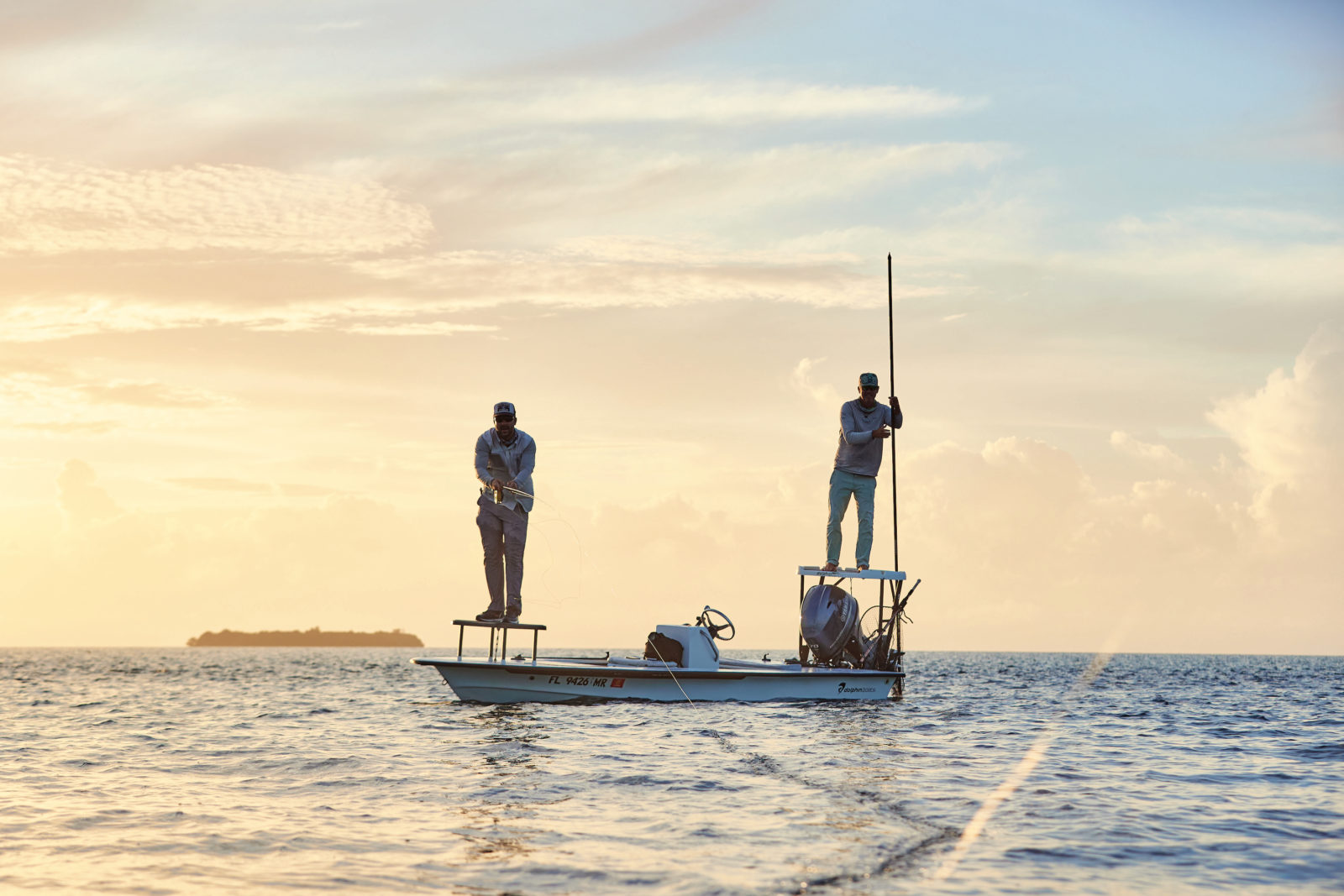
Photo: William Hereford
Captain and angler in action.
After getting clean, Linville set a goal: He wanted to see how good he could become as a fly angler. One way he could do that was by fishing in tournaments and attempting to break world records.
Fly-fishing tournaments and records are anathema to some, violating the supposed relaxing, get-away-from-it-all spirit of the sport. And outside of a somewhat hermetic world, our society has not assigned much value to these two endeavors, not nearly as much as to, say, mountain climbing. In reality, though, if you take fly fishing seriously, you do it with intent and willingly invite some level of stress, exertion, and excitement. It can mean everything, especially in the moment. And that’s the fun. “Nothing you do matters unless you decide it does,” O’Hearn says.
The Keys are one of those places where fly fishing is truly valued. Serious practitioners of the sport congregate there, just as climbers flock to Yosemite and filmmakers to Hollywood. “It’s part of the culture,” O’Hearn says. “There’s one place in the world where there’s a framework to find out exactly how good you are, and that’s here.”
Linville decided to focus on tarpon and permit. The learning curve for the latter was especially steep. “I thought I was a hot-shit fisherman, but there was a two-to-three-year period early on when I was seriously fishing for permit and not catching any,” he says. The first one he ever caught in the Keys happened by accident. “I cast my line out just to wind it up, and one ate it when the fly landed,” he says.
By 2013, Linville and O’Hearn had started to find some success. The following year, they decided to enter the March Merkin, one of the most prestigious permit tournaments. The competition would serve as a litmus test of their progress—or lack thereof. “It’s a lot harder to be optimistic about your own skills when you see, up close, other people who are much better than you are,” Linville says.
And yet, in that three-day tournament, Linville and O’Hearn had what appeared to be an insurmountable lead up until the last moment on the last day, when the guide Scott Collins and his angler, Greg Smith, returned to the dock after catching three permit and beat them by an inch. “It was incredibly painful, and the disappointment was all tied up with my recovery,” Linville says. “But that was also the point when John and I got really serious about the whole thing.”
Getting serious meant getting innovative and scientific about their approach. The first step: a new fly, the Strong Arm Merkin, designed by the fly-tying virtuoso Dave Skok. The fly was lighter than the typical permit fly, going against decades of dogma that insisted that such flies be tied with heavy lead eyes. It allowed Linville to fish with more finesse.
The next step involved creating as much repeatability in gear and methods as they could. In Linville’s home in Key West, he has twenty-five rods in various weights that hang from his wall and ceiling. Every rod is the same make and model. Same for the reels and the lines. The idea is to have a consistency of feel. Linville has marked his reels with nail polish at different drag settings so he knows, even amid the mayhem of a fight with a fish, exactly how much pressure he is applying. He has weighed his flies to figure out exactly how they’ll sink after they hit the water. O’Hearn also began to track the duo’s productivity on the water, the number of permit they caught per day of effort. The ideal number to put them “in the circle, in the hunt for tournaments and records,” he says, is one permit per day. (In their best year, Linville and O’Hearn averaged 1.3 fish a day.) They are also obsessive about their knots and adhering to IGFA-legal leaders and tippets. Linville has a tattoo on his lower left leg composed of two parallel black lines exactly twelve inches apart, which happens to be the IGFA maximum length for a shock tippet. (O’Hearn has the same tattoo, but his measures 117/8 inches. “Better to err on the side of caution,” he says.) Linville also began to wade more for permit, getting out of the boat even in water that came up to his chest, because doing so tends to make permit less wary and can provide him with more—and more effective—shots.
They analyzed every shot taken, whether it succeeded or not. They fished every booked day, rain or shine. (Over the last ten years, they’ve canceled only one trip.) Maybe most important, they had faith. “If you believe you can do it, you learn. If you don’t believe, you don’t learn,” Linville says. Adds O’Hearn: “The best permit anglers are the ones who believe they will catch the fish they are casting to.”
The scientific method and repeatability, in a paradoxical way, are even more important when fishing for an unreliable and unrepeatable fish like the permit. “The idea is to push yourself into the things you can control and pull yourself out of the things you can’t,” Linville says, words that could act as a permit angler’s Serenity Prayer.
It’s all worked. Since 2015, they have won the March Merkin three times. They broke the two-pound tippet record for permit in 2018. And in 2020, while fishing with Steve Huff and his son, Chad, Linville also broke the six-pound tippet record for tarpon with a stupendous 140-pound, 4-ounce fish. That record marked the culmination of eight years of effort and is, in terms of tippet-strength-to-size ratio, one of the most impressive catches in history.
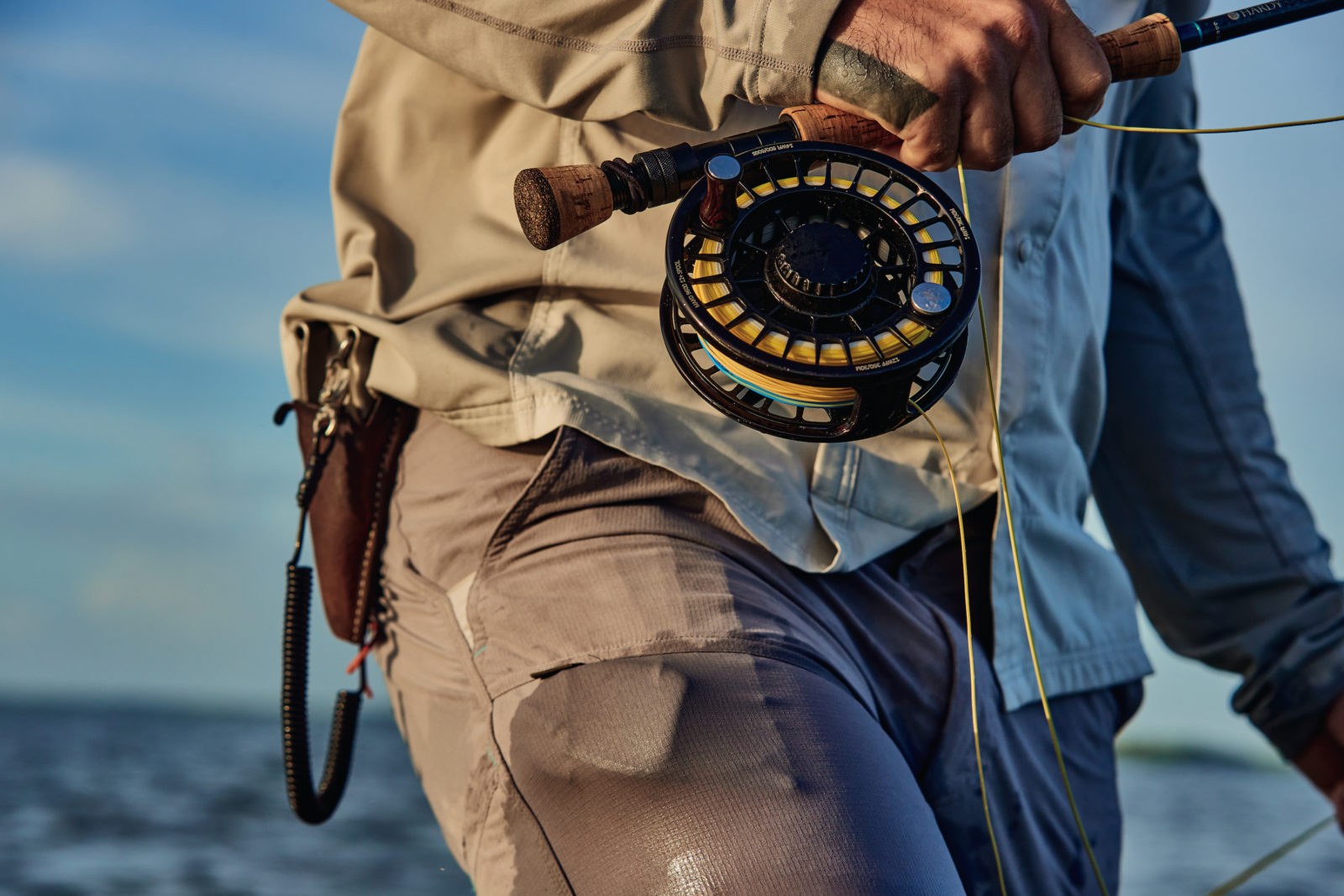
Photo: William Hereford
Wading the flats in search of fish.
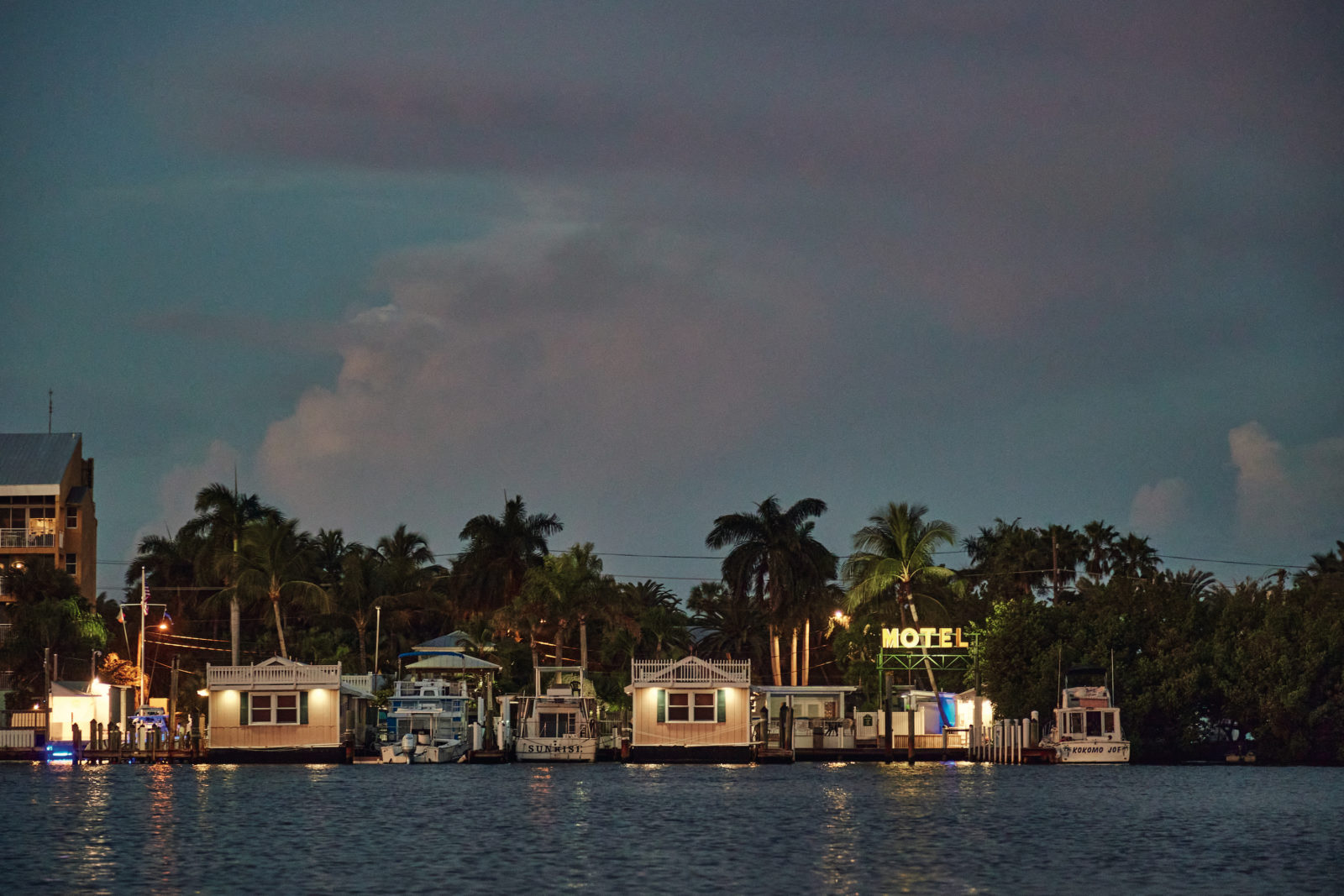
Photo: William Hereford
The view of Key West Marina as the sun comes up.
One could look at Linville’s journey and conclude, understandably, that he has swapped one addiction for another, the classic tale of the recovering addict who, say, runs so obsessively that her knees break down. While there are elements of Linville’s fly fishing that qualify as obsessive, Linville says it’s not that simple. “There’s a high I get when I fish, of course. The chemical difference between winning a tournament and sniffing a line of coke is probably not that different. But you can’t buy that tournament high for a hundred dollars, and the way you recover from it is different, and the withdrawal symptoms don’t make you sick. Addiction is not characterized by things that make you feel good. It’s characterized by doing those things at the expense of your well-being.”
A few years after he got clean, Linville met a woman named Kat Vallilee. (An accomplished angler in her own right, Vallilee holds three women’s fly-fishing records, including two for permit.) They’ve now been married for seven years, and they had their first child, Violet, last October. He and Vallilee now own the shop. “It’s rare to be able to have another chance to do things right,” Linville says. “I almost died, literally and metaphorically. I have an incredible appreciation for my wife and daughter and the shop because I could so easily have none of those things.”
In a way, he says, that appreciation is what drives him to compete in tournaments and chase world records. “I wanted to grab that chance to do something that I otherwise wouldn’t have had. It’s how I imagine it would be if you were in a wheelchair for two years and someone told you that you could walk again. I bet you’d take up running or dancing.”
During our two days together, Linville does not catch a permit, despite some seemingly perfect shots. He’s okay with that—for now. It’s his first outing since Violet was born. He’ll be ramping up his world-record pursuit soon enough.
But, in the end, Linville says, breaking records and winning tournaments, while giving the journey shape, aren’t really the point of it all. “The process is far more important than the result,” he says. Process has become an important part of his world: In the throes of his addiction, he was robbed of the pleasure of it. “People underestimate the value of doing all of this with a purpose,” he says. “It’s hard. You gain a greater understanding of the fish, the environment, the people you do it with, and yourself. There’s a lot of joy in trying something for its own sake.”




